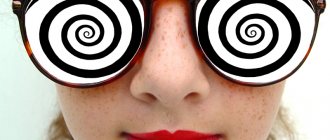Initiated people know that there is a secret door in the human mind. Most people die without ever revealing it. And that's not a bad thing. Indeed, at all times, those thirsting for power over human minds have tried to penetrate this door, believing that there is a button there, by pressing which a person can be turned into a robot.
DISGRACED MESSMER
In the 18th century, Franz-Anton Messmer, a doctor of medicine at the University of Vienna, fascinated by secret esoteric teachings, began to propagate his universal theory of treatment. Its essence boiled down to the fact that “the disease is caused by the uneven distribution of fluid in the human body.” To “redistribute” the fluid, he proposed influencing the patient with magnetic passes.
The theory was followed by practical exercises, and Messmer's success in healing was amazing. It’s just a pity that he wasn’t allowed to explore “animal magnetism” more deeply. The doctor's know-how became the subject of gossip and scandals: male magnetizers often plunged women into a somnambulistic state, and they did such things that their husbands were then simply forced to demand trial of the magnetizers.
As a result, Messmer fled, and his teaching was declared dangerous to morals. Nevertheless, he was the first to publicly declare that thoughts can be instilled in a person quite harmlessly, without witchcraft.
How to master hypnosis yourself at home - training and tips
Relaxation is the main key to inducing and entering a hypnotic trance. If a person is completely relaxed, he feels comfort and peace, then he can be hypnotized.
Before the session begins, the hypnotist may ask the person about his favorite vacation spots. This could be a spa, beach, or other cozy place where a person completely relaxes. This information will be useful when preparing for hypnosis. Some professionals recommend playing a recording of waves or other calming sounds to create an atmosphere.
Are there any special features of gypsy hypnosis? Practitioners use long-established techniques based on a combination of a special voice timbre, the use of breathing practices and texts. Gypsies sometimes manage to hypnotize people simply with a look, but more often they use a complex technique. It consists of the following steps:
- Stopping attention with a random and habitual question: “How to get there?”, “Where is the nearest post office?”
- Establishing a trusting contact. It occurs at the subconscious level and is called “psychological rapport” by scientists. Gypsies influence the unconscious with gestures, glances, increased sexual attractiveness, and a sharp removal from the comfort zone. A complex set of actions has been passed down from generation to generation for thousands of years and is not of a conscious nature; it is similar to the instincts of animals and is also carried out on a subconscious level.
- Checking the contact and condition with a sharp gesture.
- Work to achieve the desired result.
This technique is adopted from the gypsies by the criminal world and is often used in business relationships. The basis of suggestive contact is both the person’s own hypnotizability and the presence of a material interest in the hypnotist’s proposal. You can resist it only with special knowledge. If you want to understand how to hypnotize people with your gaze, it is better to take training from masters who specialize in this particular area.
You can try on your own, at home, to practice techniques that enhance the impact of a gaze. The proposed practices will make it clear what degree and strength the gaze should be, and how best to focus it. To begin to understand how to hypnotize a person with your gaze, you need to regularly perform exercises aimed at training and focusing your gaze. Among them:
- training to gaze intently and for a long time into the eyes of another person, without blinking or looking away;
- focusing on a specific point, on a pencil near the face or an arbitrary point on the wall located at a distance of 2-3 meters for 10-15 minutes without losing concentration;
- development of peripheral vision, for this you need a place with a wide view (stadium, crowded street), where you need to take a comfortable position and try to see as much as possible of what is happening to the right and left of the straight line.
After you gain confidence in the power of your skill, you can start practicing on friends. For this:
- Choose a sufficiently suggestible and sensitive one, preferably a woman.
- Ask permission to put her into hypnosis, telling her about your training and intended goal. Without expressed desire and interest, most likely nothing will work out.
- It is convenient to sit opposite each other, making sure that in case of unexpected relaxation and loss of control the person does not get hurt.
- Ask your partner to select a point above the operator’s right eye and remain focused on it throughout the conversation, maintaining the highest possible degree of concentration.
- In a practiced low voice, looking into the eyes, repeat the selected set of phrases several times, based on an introduction to relaxation. This can be either a classic technique with the phrase “your eyelids are getting heavier,” or a complex learned from any of the working trainers. It is advisable to find a complex that is suitable for a particular person and carefully rehearse it with a voice recorder, achieving the most confident sounding voice.
- After obtaining a relaxed state of the partner, “anchor” him, saying that complete relaxation will occur after touching his shoulder with his hand.
- After making sure that you are completely relaxed, report that your partner is hypnotized. He must grasp this state, accept it and feel its attractiveness.
- You can use standard combinations of words: “You only hear my voice,” or any others, but get the result in the form of an absolutely relaxed partner.
Removal from the state of hypnosis should occur in 3 counts, with a quick push. The combination of sight and voice will not be sufficient without confidence in one's abilities and the effectiveness of the practice. Knowing how to lead a person into hypnosis will not be sufficient without the personal power of the operator himself. The impact occurs based on the laws of the human psyche,
Why know how to put a person into hypnosis at home? Very often, this practice helps relieve fears or calm the inner child, treat early trauma and aid recovery from post-traumatic stress syndrome. While learning the secrets of hypnosis: how to put a person into a trance and force him to carry out his commands, one must not forget that all activities should be only positive in nature and aimed at treating diseases or relieving stress.
- study all available training and course offerings in your region or available on the Internet;
- attend 1-2 trainings on your own;
- read reviews of past classes.
HYPNOSIS
A hundred years later, the term “animal magnetism” was discarded, and it was replaced by the term “hypnosis” - from the Greek “sleep”. One of the founders of the therapeutic use of hypnosis, Braid, proposed fixing the patient's gaze on a shiny surface instead of the famous passes that were used in magnetism.
From this time on, the word “hypnosis” became associated with medicine. And certified doctors began to deal with it.
They put the patient into a trance, he plunged inside himself and completely or partially fenced off from the outside world. Whether a person was in a trance or not was noticeable by a number of signs: the patient’s pupils dilated, his gaze was directed at one point, his breathing became less frequent, his jaw dropped, his face relaxed, and there was no swallowing.
Definition of "trans"
In science, the word “trance” refers to a number of altered states of consciousness (ASC). Another definition can be formulated as follows - a functional state during which a person consciously or unconsciously performs any actions, his critical perception of information disappears, and his analytical and semantic abilities decrease.
Translated from French, trance means “to become numb”; in Latin, this word means “crossing the border of something.”
The peculiarity of the ASC is that consciousness is focused not outward, but inward. Attention is concentrated on memories, fantasies, images, sensations.
Consciously entering a trance is called meditation. This method is actively practiced in spiritual practices. Many experts understand meditation as a certain form of self-hypnosis.
Mandatory conditions of trance:
- concentration of attention,
- decreased conscious activity,
- passivity of actions,
- activation of the unconscious.
Signs of ASC:
- Stillness, concentration of gaze on one point.
- The desire to close the eyes, slow blinking.
- General relaxation, decreased reaction.
- Changing pupil size.
- Normalization, slowing of heart rate.
- Decreased respiratory activity.
- Short muscle contractions, smooth shaking of the head, trembling eyelashes.
- Literal understanding of speech addressed to a person.
Purpose
From the point of view of the human body, the ability to enter such altered states is a reaction to protect the psyche from stress, overload, and strong traumatic influences.
From a psychological point of view, trance is actively used for medicinal purposes. With the help of ASC, a person overcomes previously experienced psychological trauma. Trance allows us to give an answer to the reasons for the development of painful human conditions.
Psychologists use numerous ASC methods: accompaniment, guidance, dissociation, self-hypnosis, etc.
Accompaniment is aimed at deep and detailed immersion of the patient into his memories and experiences. The psychologist, using the “vague words” technique, creates a semantic framework that is understandable to the patient. These frames are “filled in” by the patient himself.
Management involves using the patient's existing experience to construct a new experience. To guide the patient, the psychologist uses a special script.
Dissociation allows a person to “separate,” see his body from the outside, and live through memories as an “observer.”
By the way, trance can be divided into several categories.
Light - in which a person is so absorbed, for example, in watching a movie, that he does not notice anything or anyone around him. At the same time, he reacts to external stimuli and partially hears what is being said around him. A state of light trance is similar to light sleep or dozing.
The average state of trance is characterized by muscle tension, the so-called waxy flexibility: for example, a person in this state is placed on the backs of two chairs, but he does not fall. Self-control works here, and the state can be compared to waking up from sleep, when a person is not completely asleep, but not completely awake - this is a waking dream.
In a deep state of trance, a person’s behavior does not outwardly differ much from usual - only he may mistake an apple offered by the hypnotist for a potato, and a real gun for a toy. It is this state that is glorified in detective stories about hypnotists, when with just one glance a person is forced to kill, and then he comes to his senses and does not remember anything.
With the onset of the deepest, so-called paradoxical phase of inhibition, when weak stimuli (for example, a word) are more effective than strong ones (for example, pain), high suggestibility is observed. So the deeper the trance state, the higher the person’s ability to suggest.
But, by the way, when treated with hypnosis, the healing effect does not depend on the depth of the trance. The most important thing here is to simply convince the patient that he is healthy.
Rolling your eyes to enter a trance
- Sit or lie down with your head resting on something.
- Raise your eyes upward, straining them a little.
- Take a deep breath and hold your breath.
- After 5 seconds, exhale slowly and lower your eyelids.
- Hold the exhalation for 5 seconds, then inhale deeply again, open your eyes and lift them up.
- Hold your inhalation for 5 seconds, then exhale, slowly closing your eyes a second time.
- Again, hold the exhalation for 5 seconds, then inhale, open your eyes and raise them to the ceiling, holding the inhalation for 5 seconds.
- Slowly close your eyes as you exhale and keep them closed while you concentrate on the exhalation.
- Remain in a state of deep relaxation, becoming aware of the different sensations you will experience. You are plunged into a trance, completely surrendered to the flow of consciousness, thoughts come and go. The outside world is somewhere very far from you.
After 15-20 minutes, begin to concentrate on your breaths, gradually move into a conscious state, open your eyes.
This technique allows you to enter a trance very quickly. It was developed by Dr. Herbert Spiegel, an American psychiatrist who noticed that some suggestible patients rolled their eyes while entering a trance.
Brian Rote "The Language of Hypnosis"
In this section, we will consider a simple classical method of step-by-step entry into a trance state to extract information from the subconscious and foresee the future.
HOW TO INSPIRE A PERSON THAT...
In order for a person to begin to act according to the program you need, you must first establish contact with him - join him. To do this, you need to communicate with your counterpart without crossing or squeezing your hands, quietly trying to copy his manner of speaking, gestures and breathing, but so that he does not notice it. We all really love people who are similar to us - unconsciously, if I may say so, your partner will begin to like you very much. And if this happened, then he is ready for suggestion.
The next stage is to take over the situation. When making this or that gesture, pay attention to whether your partner will repeat it after you. If yes, the connection has occurred. If not, you are losing the initiative. Experience shows that if the connection did not occur within the first five minutes of communication, it is useless to try further.
Next is an introduction to trance. Trance causes any unexpected (possibly shocking) action, rhythmically repeating movements or sounds: drumming, head shaking, smacking, rubbing hands, concentric movements on the surface of a table or knee. It is best if these movements are perceived with peripheral vision.
So, if you enter the center of a psychotherapist and see that on the sides of his table there are shiny “perpetual motion machines” swaying with a uniform sound, you should know that the owner of the office is trying to lull his patients to sleep. The same effect is achieved by fountains, water and light mills-lanterns. Rhythmically repeating monotonous speech can also cause trance.
How to put a person into a trance?
Get the consent of the person you will practice on. Please note that if he does not believe in the effects of hypnosis, is skeptical about this method of treatment, or is afraid that the session will be unsuccessful, nothing will work out. For trial meetings, choose a person who will listen to you and carry out all your orders. Hypnosis cannot be used on mentally unstable people who have nervous disorders and pathologies of brain activity.
Most people have little idea what hypnosis is and what effect it has on the body, so the preparatory conversation must necessarily include explanations on this topic. This is done so that your interlocutor has an idea of what will happen to him and is not afraid.
It is equally important to understand why a hypnotherapy session was needed and what problems he wants to solve in this way. Very often, hypnotic sleep is resorted to to relax, relieve the effects of stress, increase the body's defenses, increase concentration and enhance mental activity.
You should find out whether the person has attended similar sessions before. Scientists have found that people who have been hypnotized fall into trance more easily in subsequent sessions. If a person is turning to hypnosis for the first time, keep in mind that it will be much more difficult for you to work with him.
Situation
Find a secluded room where no one will disturb you. It is important that your interlocutor is calm and relaxed. He should feel comfortable around you. Invite the person to take a comfortable position in a chair or on the sofa. Turn on quiet music that will accompany all your actions. Remove distracting objects, turn off the TV and phone - no one or nothing should interrupt you.
The hypnologist needs to create a calming environment so that the patient can relax
Procedure
The session should begin with the following phrases: “You are safe! You are calm and peaceful! Your eyelids are gradually getting heavier! The body relaxes, you feel comfortable and good! Peace envelops you! You listen carefully to what I tell you and follow all my instructions!”
It is necessary to regulate the breathing of the person you are putting into trance. To do this, he needs to take not very deep and frequent breaths and slow exhalations. You can breathe at the same time as your interlocutor, then it will be easier for him to adjust to the desired rhythm. The main thing is to control his actions: “Take a deep breath and fill your lungs with air!”
Once your breathing is synchronized, let your feet relax, then your knees, hips, torso and arms, gradually reaching your face. Give the person confidence that everything is going well and he is doing a great job with all your commands.
After complete relaxation, the partner should immerse himself. Concentrate his attention on the inner sensations: “You are safe and completely relaxed! Your body is covered in bliss and warmth! Peace and tranquility accompany your every action! A feeling of heaviness in the muscles covers the whole body, and you gradually fall asleep!
How to do hypnosis to guarantee results? Most likely, you won't be able to do it the first time. The hypnotist must have the power of suggestion and self-confidence. Not everyone can put a person into a trance. But you can try, and perhaps after a few tries you will succeed.
This technique is not available to everyone: only a person who has magnetic abilities from birth can be immersed in a trance with just one glance. Requires training. Do the following exercises:
- Using a compass, draw a clear, even circle on a white sheet of paper. Periodically practice looking at the center of the circle without blinking. During training, you need to not think about anything - when you learn to look at one point for five minutes without a single thought, the exercise will be considered completed.
- You can also train with a mirror in the same way. You need to look closely at the center of the forehead. Start with three minutes and gradually increase the duration of the workout.
After two or three months, you can try your hypnotic skills on your friends. Find a test subject and ask for help. To put a person into a trance, look closely and without blinking into his eyes.
The monotonous movements of the pendulum can lull and put any person into a trance. There are several rules:
- The person you are about to put into a hypnotic state should lie down or be in a semi-sitting position.
- Before the session, talk to the subject, he should be calm and relaxed.
- Before starting the session, agree on what will be the signal after which the person will leave the trance. For example, you clap your hands or snap your finger.
- Then prepare a pendulum and start swinging it in front of the eyes of the person being put into a trance. The subject must continuously monitor the movements of the pendulum.
After 2-3 minutes, immersion in hypnosis should occur. After this, you can ask questions or recite information that needs to be conveyed to the patient. At the end - clap and exit from the trance state. The maximum time you can be in a state of hypnosis is twenty minutes.
CONSENT SIGN
Every person has an internal censor that resists external influence. For example, when you agree with someone verbally, this does not mean at all that you really agree with the arguments of the interlocutor - at that moment you can think whatever you want to yourself. So this internal censor can be safely put to sleep. It is believed that if the number of agreements you have with your partner is less than or equal to four, you retain your opinion, but then you get tired and the fifth information is accepted by your brain as your own.
For example:
"It's a good weather today?" - "Yes".
"We are going to the shop?" - "Yes".
“Are we going on a smooth road?” - "Yes".
“Are we going to the grocery store?” - "Yes".
“You value me very, very much and will increase my salary.”
The answer to the last phrase will be... positive in any case.
This method is called 4+: four of his consents - one of your settings. Further, formulas 3+2 are acceptable, that is, three of his or her forced consent (your patronymic is Fedorovna, your cat’s name is Masha, you love summer), then two phrases that you need. The next step according to this scheme is 2+3, then 1+4, and then, if you managed to carry out the whole process - from 4+1 to 1+4 - you can say whatever you want - the person is yours.
If conversational suggestion still seems too complicated to you, try, looking into the eyes of your interlocutor, imagining that the person is experiencing the state you need. If you want him to be afraid of you, try to experience fear yourself; If you want him to want to eat, make yourself feel hungry.
Immersion in hypnosis
To hypnotize a person using instant hypnosis, you can use different methods of influence. The use of verbal formulations is typical. They help to describe in detail the sensations into which the suggestible person will be immersed. The practitioner can apply pressure to analyzers and strong stimuli.
Practitioners can induce a hypnotic state by fixating on an object. The patient must look intently at any object without taking his eyes off it. For this purpose, you can use a key, a pencil, or coins that are hung on a rope. You don’t have to be limited when choosing a subject.
What is modern hypnosis, or more precisely, hypnotic trance in today's view?
Even 10 years ago they said that hypnosis is a special state that is neither sleep nor wakefulness, i.e. it was defined through states that it is not, because They couldn’t define it because modern hypnosis is NOT a condition.
And although Dave Elman, one of the most famous specialists of the 20th century in the field of hypnosis, gave an axiomatic definition of hypnosis back in the 50s: “hypnosis is a mode of operation of consciousness in which the critical ability of consciousness is not taken into account and selective thinking functions”
, this definition did not become generally accepted at that time.
You can use the metaphor of fire. Modern hypnosis, or more accurately the hypnotic process, is a little light that everyone has. When it's small, it's not activated and it's not very useful. When the process is activated, the flame flares up, the hypnotic process unfolds and then it becomes useful. And within the body, changes are taking place in the relationship between the body and its “supreme commander.” These changes, for example in cases of pain, will lead to a decrease in pain or even anesthesia. And in the psychological field - reducing anxiety or dynamizing neurons that were blocked by a depressive state.
Criticism of Milton Erickson. Position of A. Weisenhoffer.
It so happened that “Ericksonian hypnosis” has become similar to the Reiki method of manual healing or clearing the chakras in meditation, because “Ericksonian teachings” are not subject to experimental verification. There are not even the most important statistics on the successful and not so successful cures of both Milton Erickson himself and his followers. There are no clinical studies that contain an analysis of the use of a “new” method of therapy. It’s worth thinking about why this is so, is this the basis of any scientific theory? Or, as often happens, many works have not yet been translated into Russian?!
Criticism of Milton Erickson's approach. The position of A. Weitzenhoffer, who was one of the most prolific researchers in the field of hypnosis in the second half of the twentieth century. Weisenhoffer authored more than 100 publications between 1949 and 2004.
It is useful to familiarize yourself with Weisenhoffer's position, especially since, I quote “...In addition, on several occasions when M. Erickson performed informal trance induction in the presence of A. Weisenhoffer and other observers, doubts arose about the real presence of trance. Erickson, in a number of cases, was inclined to act with minimal or no trance...”
“... In 1992, at a conference dedicated to Ericksonian hypnosis and psychotherapy, one of the most authoritative elders of American hypnology, A. Weisenhoffer, spoke. The topic of his report was “Erikson and the unity of hypnotism” [1]. A. Weisenhoffer poses and positively resolves the question of the integrity of hypnotism as a scientific discipline and practice. Here are his starting positions.
After Milton Erickson's death in 1980, his students and followers began to draw sharp distinctions between "traditional hypnosis" and "Ericksonian hypnosis." However, these differences are justified by extremely vague arguments. Thus, according to Yapko [2]:
- traditional hypnologists believe they have power over their patients; So what
- Traditional manuals indicate the impossibility of hypnotizing psychotics. A. Weisenhoffer, who is the author of manuals and is well aware of North American hypnology of the 20th century, categorically denies the first statement, and the second is confirmed by only two authors out of many specialists.
Ericksonians describe traditional hypnologists as authoritarian, controlling, dominant, operating according to set rules, formulas and scripts, like a cookbook in the form of time-limited recitations loosely tailored to the patient's personality. Clinical hypnologists are involved in the forced removal of symptoms according to the “medical model”. Traditional hypnology uses suggestion only on the basis of formal hypnotization, followed by a formal deepening of the state of hypnosis and a formal assessment of the depth of the state. From the perspective of traditional hypnology, there are absolutely non-hypnotizable subjects. A. Weisenhoffer denies all of the above statements by Ericksonians regarding authoritative theorists and practitioners of American hypnology and notes that such conclusions cannot be substantiated by discriminatory examples from the practice of insolvent amateurs. In addition, the Ericksonians practically did not take into account the achievements of European hypnologists.
Until 1961, when M. Erickson began to have a real influence on the clinical community, hypnotism in its development went through delineated evolutionary phases, initiated in Europe by the works of I. Bernheim [3,4], which substantiated the generally accepted “doctrine of suggestion.” In America, Bernheim's doctrine was accepted after the translation of his works into English after 1895. A. Weisenhoffer considers Bernheim's doctrine to be the foundation of hypnotism of the 20th century. It includes the following provisions [3].
- Suggestion is the leading agent that determines all hypnotic phenomena, including hypnosis, i.e., suggested sleep.
- Hypnosis, like a suggested dream, is a type of sleep.
- Hypnosis does not create suggestion, but enhances it.
- In general, any states that enhance suggestibility are components of the state of hypnosis.
- Hypnosis, as a state of sleep, is characterized by depth, and suggestibility is the latter.
- Suggestibility is manifested through a holistic behavioral class of signs that can be classified as “automatisms” and are reflexes in nature.
- “Ideomatic action,” which is a reflexive transformation of thought into action, is the leading automatism that underlies all suggested phenomena.
- All automatisms express “internal psychism,” opposed to “external psychism,” which is the focus of all consciousness and voluntary acts.
- All hypnotic behavior belongs to the realm of normal behavior, normal psychology.
Later, Hippolyte Bernheim abandoned the routine reduction of hypnosis to suggested sleep and defined hypnosis as the induction of a specific physical state that increases suggestibility [4]. Bernheim made several attempts to define suggestion. Thus, in 1886, he argued that suggestion is the intense influence of an idea that has been instilled and perceived by the mind [4]. In 1903, he argued that all ideas are perceived by the brain through suggestions. All suggestions have a tendency to become actions, to manifest themselves [4].
Bernheim was not the first to connect the phenomenon of hypnosis with suggestion. Among his predecessors, A. Weisenhoffer names Faria, Braid, and Philips. In the concept of ideomatic action in response to suggestion, Bernheim is also not original. His predecessors are Carpenter, Braid, Chevril.
I. Bernheim understood hypnotherapy as part of psychotherapy and, in the process of his evolution, resorted less and less to the use of hypnosis, preferring to use suggestion while awake. Comparing the concept of I. Bernheim with the views of M. Erikson, A. Weisenhoffer defines the latter as a Bernheimian.
Since 1970, M. Erickson began to gain a reputation as a highly effective hypnotherapist, and since 1975, a small group of individuals, including Haley, Bandler, Grinder and Rossi, who became his followers, have devoted some effort to identifying what made Erickson so effective . A. Weisenhoffer notes that similar attempts had been made earlier; in 1950, the author himself, Haley and B. Gorton met occasionally with Erickson. Based on personal observations, A. Weisenhoffer states that he does not believe in the highest effectiveness of Erickson as a hypnotherapist in comparison with his other, more famous colleagues at that time.
According to A. Weisenhoffer, already in the understanding of hypnotherapy by Bernheim and Braid there is nothing that would fall under the definition of a “traditional approach”. Bernheim's general definition of hypnosis allows us to move on to its naturalistic use. The question arises: why did leading hypnotherapists and researchers use so-called “traditional hypnosis”, while Erickson alone chose the opposite direction?
According to A. Weisenhoffer, those who came to such conclusions did not make any real effort to practically study the issue under consideration. Moreover, there is no evidence that they studied the works of other hypnologists. In general, the data on which the Eriksonian waters are based are inconclusive. Anyone who had even an open mind to read the works of Wolberg and Linder would be convinced that they are far from the “traditional approach.” The hypnotherapeutic practices of LeCron, Secter, Hershman, Aston and Cheek are far from the criteria of “traditional” hypnology. Indications that before 1961 there were “traditional” elements in the hypnotherapy of M. Erickson’s colleagues are not confirmed. A. Weisenhoffer gives a different explanation for the emergence of the fundamental idea of traditional hypnosis. The founders of Eriksonianism were mostly formed as psychotherapists (psychologists) and assessed clinical hypnology from the position of psychologically oriented psychotherapy. However, the basis for the clinical application of hypnosis is much broader than that of psychologically oriented psychotherapy. In addition to psychotherapists, other clinical specialists and dentists also make extensive use of hypnotism. From the Ericksonian perspective, the use of hypnosis by specialists appears to be “traditional.” The use of “traditional” features does not imply the presence of a corresponding fundamental approach and philosophy. The approach is always determined by the purpose and type of psychotherapy.
These remarks fully apply to the so-called standardized approach, distinguished by Yapko and Gilligan [5, 2], who distinguish it from the traditional and Eriksonian approaches. A. Weisenhoffer sees no reason to identify a new category.
In general, A. Weisenhoffer deeply doubts the legitimacy of using the “traditional hypnosis” stereotype. On the contrary, like his other academically educated contemporaries, adapting the basic principles of I. Bernheim, M. Erickson followed his own, perhaps original, path of applying the phenomenon of hypnosis. In this, like his colleagues, he was driven by his perception of the nature of psychotherapy based on his roles and idiosyncrasies. Various explanations given by Erickson support the notion that he considered hypnotherapy to be a methodical application of one's knowledge of hypnotic phenomena to therapeutic purposes. As for some of the statements attributed to Erickson by his interpreters, A. Weisenhoffer believes that they are not genuine, but represent hypotheses of his author. As Fink suggested [1], Erickson acted on intuition, which is typical of all successful psychotherapists.
A feature of M. Erickson's practice was the creation and use of confusion techniques to develop and use a hypnotic state. He avoided the use of formal trance induction. Just as for Bernheim, for Erickson, over time, the presence of a hypnotic state for the implementation of suggestion became less and less important. It is possible that observers saw nondirective induction where there was none. In addition, on several occasions when M. Erickson performed informal trance inductions in the presence of A. Weisenhoffer and other observers, doubts arose about the actual presence of trance. Erickson, in a number of cases, was inclined to act with minimal or no trance. Erickson was more adept at using suggestion and its effects than at producing a hypnotic state. Many of his techniques, such as double bind, reframing, paradoxical intervention, utilization, have universal applicability, but are not strictly hypnotic. The lack of distinction between suggestion and hypnosis leads Ericksonians to paradoxical conclusions. Thus, Yapko [2] baselessly claims that all effective communications are hypnosis.
A. Weisenhoffer notes that the directive removal of a symptom by suggestion is nothing more than one of the varieties of hypnotherapy among psychoanalytic, behavioral, Bernheimian, Ericksonian and others. This technique is no more “traditional” than others. Wouldn't it be more accurate to evaluate the actual effectiveness of a particular approach?
A. Weisenhoffer considers the assertion that Erickson introduced anything fundamental, methodologically new in relation to hypnotism as such unconvincing. Differences in the “modus operandi” level determine superficial, but not essential, fundamental differences. Erickson, in his opinion, made a contribution as a practitioner of psychotherapy, but not of hypnotherapy. All of the above, A. Weizenhoffer believes, does not diminish the importance of M. Erickson’s activities. His effectiveness as a psychotherapist may have been very real, but for reasons other than those accepted in Eriksonianism.
Bibliography
- Weitzenhoffer AM Erickson and the unity of hypnosis // Jerusalem Lectures on Hypnosis and Hypnotherapy. Hypnosis International Monographs Number 1. Munich, 1995. P. 1-16
- Yapko M. Trancework. Brunner & Mazel, 1990.
- Bernheim H. Hypnotisme, suggestion, psychotherapy avec considerations nouvelles sur I'hysterie. Paris: Doin, 1903.
- Bernheim H. De la suggestion. Paris: Albin Michel, 1916.
- Gilligan S. A River runs through it: The Relational Self in Psychotherapy // Munich Lectures on hypnosis and Hypnotherapy Hypnosis International Monographs Number 2, Munich. 1996. P. 195-210....”
© Material taken from a separate book of Tukaev’s book “Mechanisms and methods of clinical hypnotherapy” (pp. 48-52). For this rare work, the author of the site would like to express his deep gratitude to Rashit Dzhaudatovich.
Article rating:
(
1 ratings, average: 5.00 out of 5)
Share with friends:
Hypnologist Boris Bork
02. TRANCE Previous chapter - Unconscious. - Mur-mya! - Hello, Baxi. I've eaten, shall we continue? Why so thoughtful? - Me? - Okay, then let me answer the questions right away, and then we’ll continue. What don't you understand? - Me? - Good question! The main thing is original! What the unconscious is, I’ll tell you a secret, no one really knows. They even call it differently. Yes, it doesn’t matter. You don't know how a refrigerator works! And that doesn’t stop you from getting sausages from it.
You just realized by observation that there were sausages. You don't even care where they come from. It's about the same with the unconscious. There are specially trained people. They call themselves differently - psychiatrists, psychotherapists, psychologists, philosophers.
They are very interested in how we think, think, feel, and act. So they found out that our brain consists of two hemispheres, left and right. - Me? - The left one, this is where your ear is torn. By the way, it is in the left hemisphere that consciousness is located, and the right hemisphere is responsible for unconscious processes. Of course, this is conditional, especially since these hemispheres are very closely connected with each other. I'll explain it to you more easily.
With ordinary vision, you see a huge number of details in the picture, at the same time you hear, smell, and sometimes feel. All this is recorded by the left hemisphere of the brain, and at the same time goes to the right hemisphere, which gives you information - what to do - run away or catch up, or do nothing, then receive information.
Sometimes you just smell a smell, or a rustle in the grass, and the unconscious already gives you the answer that there might be a mouse nearby, and even corrects your actions accordingly. You freeze abruptly so as not to scare him away. And all this happens automatically, apart from your consciousness. Consciousness is still trying to analyze, but you are already frozen, waiting for further commands. Suddenly a tail flashed in the grass, you still didn’t have time to think of anything, but the paws themselves tore you off the ground and threw you in the right direction. - Me! - That's it. You correctly noticed that during a hunt there are practically no thoughts. Everything is somehow done quickly, mechanically and accurately. This is the work of the unconscious part of the brain. This is not a very common condition. There are no thoughts, they just don’t have time, and you act. And these actions are always accurate and correct.
This is the state of trance. When the activity of the left, thinking, hemisphere of the brain is slightly inhibited, and the right hemisphere, what is in charge of the unconscious, is activated at this moment, and almost directly commands you. Here, ideomotor skills are included, along with all life experience and reflexes. In general, all the necessary resources of the unconscious. And there are tons of them there! - Me! - I don’t really know how it works. But it works! And it works flawlessly. And if it works during a hunt, then it can be used in other situations. One has only to find oneself in this trance state, and everything will begin to operate accurately and accurately. At a minimum, the flow of thoughts in the mind will turn in the right direction.
Now I understand what power, strength and wisdom this unconscious conceals within itself! This is not for you to open the refrigerator. Here you find yourself in a central food warehouse of strategic importance. Moreover, I have the feeling that all the age-old wisdom, the experience of all generations, is stored there. When did cats appear on earth? - Me! - Come on! What, before man? Are you as homey as you describe? Who built your houses? -Me! - Okay, okay, I believe it. Then you can tell me how it turned out for you and the cats. We have confusion here too. According to the Old Testament, you and I appeared at the same time, according to Darwin, monkeys had to build your house. It's kind of muddy there. Shall we continue? Is it roughly clear with the unconscious? Any questions? - Me? “So you practically came up with the definition of trance yourself!” This is a condition when the activity of the left hemisphere is slightly dulled, and the activity of the right hemisphere of the brain is activated. Professor M.R. Ginzburg, from whom I myself studied, calls trance - the internal focus of attention. This is when all your attention is focused on your inner world.
In fact, deep thoughtfulness clearly demonstrates a trance state. Psychologists have other definitions. They even distinguish between types and degrees of trance, using different formulations and terms. It doesn't matter to you and me. We don't do science. For us, at the everyday level, it is quite enough for us to learn to enter a state of trance, you can call it - hypnotize yourself. Next, it would be good to maintain this trance state for the necessary time.
Well, the most important thing is how to use this state. This is perhaps the most important and interesting. So for us, Ericksonian hypnosis, a hypnotic or trance state, just trance are synonyms, one and the same. Agreed? - Me? — If you want to study deeply, from a scientific point of view, for professional activities, then you need to contact Professor Mikhail Romanovich Ginzburg. Here he is a real scientist, psychologist, doctor of science. The most important specialist in Ericksonian hypnosis in our country. Only, as far as I know, he doesn’t train cats. Even after I finished studying with him, I spent two months trying to get a personal consultation. And who will drive you? You don’t have a car, but you get seasick on the subway, I said it myself. - Me. - Okay, let's continue. Where did we leave off? - Me. - Yes. Ideomotor is an interesting thing. But we will be brief, just to understand the process itself. Your thoughts, the most ordinary thoughts, cause feelings. So you thought about your neighbor’s dog, you just remembered it, and the hair on the back of your neck rose a little. Completely involuntary. Because one day she, this dog, scared you greatly. You immediately remember how she pushed you onto the rafter beam when we were building the veranda. You couldn’t come down from that height on your own, it was scary. But somehow he jumped in.
And if you remember your cat, or Red, your friend, on the contrary, it becomes pleasant and your tail rises like a trumpet with pleasure. But there is no one nearby. You just imagined it. We can imagine anything. I don’t know about cats, but humans’ imagination is simply limitless. - Me. - You see, you can imagine everything too. And depending on what you imagine, involuntarily, against your will, the body reacts in a certain way. Imagine the winter cold, and they forgot to let you into the house, and you will probably shiver, your fur will fluff up on its own. Just imagine the food and your mouth will water. And if you imagine me scratching you behind the ear, your head will tilt slightly, as if I were really scratching you.
And all this happens against your will, involuntarily, automatically. According to the scientist, this is called the dynamic manifestation of the presented image. Or simply ideodynamics, or ideomotor. You and I don't need learned words. Just remember - your body responds accordingly to any image presented.
So, such a response from your body to the created mental image is the prerequisite and basis of hypnosis. It is important for you to simply remember that any image that you imagine in your head automatically, against your will, evokes certain emotions, sensations, mental flow, and most interestingly, involuntary actions, muscle reactions. But even the smallest actions can be used very effectively.
And most importantly, these automatic actions are surprisingly accurate. There are no mistakes here. It’s your unconscious that acts, and it never makes mistakes. And the brighter and more emotional the image presented, the more powerful the response of the unconscious is manifested. All hypnosis is based on this. We will talk about this with you more than once. You also need to be able to imagine, you will have to learn. - Me! - Of course we will learn. Catalepsy and levitation are based precisely on this principle. These are such hypnotic phenomena. Absolutely no mysticism. Catalepsy, Greek word. It's like freezing, remaining motionless for a long time. Now, if you are greatly frightened or surprised, you instantly fall into a trance state and freeze.
There are even ways to induce a trance. Very effective, but not very comfortable. And they are not suitable for self-hypnosis. Well, how will you surprise or scare yourself? But the phenomenon itself in self-hypnosis is very convenient to use. Now I'll show you. - Me! “You don’t really need to do anything special.” In humans, catalepsy usually occurs in the hands. This is when the arm is raised, supported by the elbow joint, and the hand hangs out, as it were. A position is selected in which it can freeze freely, without tension, and naturally remain in this position for some time. With this catalepsy you can go into a trance and do some other useful exercises. Only you don't have any hands. Okay, let's adapt. As a last resort, we will do tail catalepsy.
By the way, about the tail. But levitation of the tail is very convenient to do. Levitation is, on the contrary, movement. I levitate my hand myself, but it will be more convenient for you to use your tail. Shall we study? - Me. - Come on, I'm tired! Do not make me laugh. You're just afraid that your tail will come off! You have no reason to worry. Ericksonian hypnosis is a very pleasant, comfortable and completely safe activity. Apart from benefits and pleasure, absolutely nothing. Milton Erickson argued that trance itself was therapeutic. Just plunging into a trance is already pleasant and useful. You'll see for yourself. In essence, this is the same relaxation. Do you want to try? - Me. “Then make yourself comfortable so that you feel comfortable and as relaxed as possible.” Like this. Now you will do what you love most, that is, doing nothing. I promised you that it will be comfortable and pleasant. So enjoy it. Begin.
...Relax your muzzle, there are muscles there too, feel how they relax. You can also relax your neck. Peace of mind, comfort, safety. Gradually relax your chest. Don't rush, we have all the time we need. Feel the muscles of your front paws relax. Very good, nice.
Check the tummy, how relaxed it is, the hind legs, and so on to the tip of the tail. Great, warm. Mentally check if everything is completely relaxed. We have nowhere to rush. Fine. When your eyes want to close, you can allow them to do so. Let them close, relax, rest. Wonderful.
Some pleasant thoughts probably come into your head. You remember something, or imagine something pleasant. You can continue doing this. Something pleasant to remember or just fantasize about. Your thoughts can remember one thing, or go through something pleasant, like in a kaleidoscope.
You can feel the lightness or the thickness of the darkness. Sometimes sensations, such as warmth or coolness, may emerge. Odors can often be smelled. And if you feel them, you can enjoy them again. Sometimes even the taste is remembered, but this is not always the case. But the sounds are remembered quite often. Very good. It's nice to be in a comfortable, cozy, safe place, just enjoy your pleasant thoughts. There is no need to think about anything. Just enjoy the state of peace, tranquility. Very good.
In moments like these, when you are calmly and joyfully interested in observing your body. Feel the ears, mustache, paws, tail. It's nice to feel their relaxed calm. Sometimes it may seem that some part is becoming warmer or heavier. Or vice versa, something will seem lighter, perhaps even weightless. There is often a feeling of lightness, as if light weightlessness. You may feel that one paw has become a little warmer or lighter, while the other, on the contrary, can fill with a pleasant heaviness.
It is very interesting to observe when such processes occur. Sometimes they are subtle, sometimes very distinct and noticeable. You can even feel small muscle contractions. Light, pleasant, barely perceptible feeling of movement. It can be very interesting to watch your own tail. It may seem that it has become completely weightless, and even a light breeze can lift it like a feather. He is free to move.
There is no need to control his movements. You can completely relax, let him behave the way he wants. And if you feel that it is starting to rise on its own, you should not interfere with this. You can calmly give him the opportunity to rise. At the same time, it is interesting to feel how this happens. How the tail rises on its own and is in a free position. He is as free and calm as you. Very good.
Now that your tail is so calm that it can lift itself off the chair, it is very interesting to watch its movements. He can already move independently. I wonder where the imaginary light breeze will direct its movement. Perhaps it will simply hover in the air, perhaps continue to rise or make other movements.
And you have all the time you need to calmly enjoy these new sensations for you. And if you feel that the tail has begun to slowly descend, you should not interfere with this. Just watch him slowly, calmly, comfortably sink lower and lower. Very good, just wonderful.
And when your tail completely falls on the chair, you can feel a surge of energy, strength, take a deep breath, stretch, open your eyes and return to your normal state. Wonderful.
Congratulations on a great start. You did the best. Simply wonderful. - Moore! - Yes. This was hypnosis, or trance. -Me? - Of course, you heard and felt everything. There is no loss of control. You can always, at any moment, come out of your trance. You just need to take a deep breath and open your eyes if they are closed. -Me? — Almost everyone says this when they dive into the race for the first time. Indeed, it is so pleasant and comfortable that you don’t want to leave. How long do you think passed while you were in a trance? - Me! - Here's another hypnotic phenomenon for you. Only four minutes had passed. I specifically timed it. You were wrong five times. This is completely normal. Time passes very differently in hypnosis. Changes its speed significantly. It can stretch, or it can shrink. - Me? - Yes, Baksi. What was happening with your tail is levitation. You see, you did it great the first time, and quite quickly. Not everyone can do this, you're just smart. - Me!? “I understand that you are bursting with curiosity.” You felt new sensations. But let’s stop here today, tomorrow I’ll answer your questions. And today, if you have the desire, you can try to hypnotize yourself. Just do the same as we did. - Me? “You don’t have to remember what I told you.” This won't work. You understood the main thing, right? I hope I even felt it. Essentially, the trance state is achieved by changing the focus of attention. Usually your attention is focused outward. This is understandable, it is very important. After all, danger lurks outside, and food is running around in the outside world. This is a common condition.
In a trance state, you direct your attention as if inside yourself. It’s as if you listen to yourself, sniff. Professor M.R. Ginzburg also calls hypnosis a game of attention. This is where the trick lies, literally and figuratively. You need to turn this attention inward and focus it on something.
If I help you enter the trance, I will be your personal hypnotist, then I can offer you to look carefully at any object, or just into my eyes. It makes no difference what exactly to focus your attention on. In self-hypnosis, it is most effective to concentrate on your sensations.
That's why you and I relaxed our muscles. I helped you concentrate your attention on your own sensations of muscle relaxation. Then I helped you switch to pleasant memories and focus your attention on that. After that, attention concentrated on the tail. - Me! - Absolutely right. You constantly concentrated your attention on your feelings, memories, fantasies. This internal focus, concentration of attention is the basis of the trance state. The main thing is that you understand.
You need to focus your attention on something within yourself. It doesn't matter what. These are memories, fantasies, sensations, feelings.
So, sit back, relax and reminisce. Concentrate your attention. To begin with, the easiest way is to deal with pleasant memories. It doesn't matter what you remember. The main thing is to create pleasant, bright images in your head.
Just remember, or fantasize. Don't forget to complement your images with light, sound, warmth or coolness. Be sure to include emotions and sensations. The brighter the image, the more versatile and emotional it is, the more effectively you can use your trance state. This is quite enough. Try it, it will definitely work. You are talented. That's it, go to the attic to train. - Moore!
Continuation. Chapter 03 Cosmic Flow
Modern hypnosis. Different types
It should be clearly understood that the concepts of “regressive hypnosis” and the hypnosis that we usually think about when we mention this word (circus / gypsy / Kashpirovsky) have nothing in common with each other, but are only homonyms (i.e. they have completely different meanings, such as onion and bow with arrows).
To claim that these 3 types of hypnosis have no differences is as ignorant and unfounded as the claim that medicinal diethyl ether, essential oil and ether (as the primary element, the fifth element) are the same thing. Regressive hypnosis does not suppress the will of the subject, but, on the contrary, promotes its development and is more comparable to guided meditation.
EVEN SIMPLE: Have you ever seen a person in meditation or images in a light slumber? Does this seem dangerous or impossible to you? It is in this state that everything happens in regression sessions, nothing supernatural.










